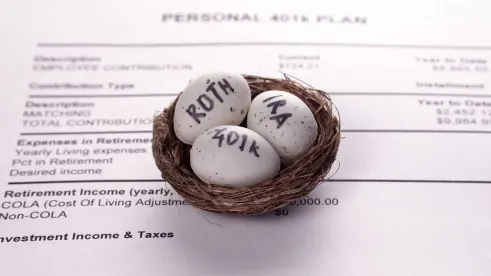The SECURE 2.0 Act of 2022 (SECURE 2.0) contains several provisions that allow the federal government to have its cake (more tax dollars) and eat it too (more retirement savings, easing Social Security challenges). With SECURE 2.0, we find more Roth, more catch-up, and catch-up as Roth.
More Roth
Named after the late Delaware Senator William Roth, Roth IRA first became a savings opportunity in 1998. Starting January 1, 2006, the Economic Growth and Tax Relief Reconciliation Act of 2001 (EGTRRA) added this design feature to 401(k) plans. Although, for the most part, Roth deferrals are treated like pre-tax elective deferrals for plan purposes, they differ in two material respects:
-
Roth deferrals are subject to income taxation when contributed to the plan; and
-
If all of the applicable requirements are met to comprise a “qualified distribution,” the earnings that accrue with respect to the Roth deferral will avoid taxation when distributed.
Roth elective deferral opportunities and in-plan Roth conversion and rollover opportunities have become relatively common plan features. They have the potential to create powerful savings tools, especially for those in lower income tax brackets.
Roth treatment historically has been limited to elective deferrals. That changed with SECURE 2.0. Effective now (i.e., the date of enactment of SECURE 2.0), Section 402A of the tax code permits 401(k), 403(b), and governmental 457(b) plans to permit employees to elect to have employer matching or nonelective contributions treated as designated Roth contributions.
This avoids the need for participants to jump through the hoops of electing an in-plan Roth conversion with respect to these employer accounts, if permitted by the plan, to achieve this result. This also has the potential to produce marginal tax savings on the accumulated earnings if Roth treatment is elected at the time of contribution (rather than conversion).
Although immediately effective, employers interested in this opportunity likely will have to wait until payroll and recordkeeping systems are updated to accommodate this change.
More Catch-Up
Those among us who are familiar with 457(b) plans and 403(b) plans know there are special catch-up contribution rules permitted in these plans that provide enhanced savings opportunities to those approaching retirement age. The concept is simple – let employees save more as they are preparing for retirement.
For example, Section 403(b) plans can allow employees who have at least 15 years of service to defer up to a lifetime maximum of $15,000 more into the plans than the customary 402(g) deferral limit of $22,500 in 2023. The annual amount is determined using a formula that takes into account years of service, prior elective deferrals, and prior Roth deferrals.
Likewise, 457(b) plans can allow special catch-up contributions during the 3 years immediately preceding normal retirement age. This allows eligible participants to double their deferral limit or contribute the annual limit plus the amount they did not contribute during prior years, whichever is less.
Section 109 of SECURE 2.0 brings this concept to 401(k) plans. Starting in 2025, participants who are age 60, 61, 62, and 63 will be subject to a higher catch-up contribution limit. In lieu of the standard Section 414(v) catch-up contribution limit applicable to those who are age 50 or older ($7,500 for 2023), these eligible participants approaching retirement may defer the greater of $10,000 (indexed) or 50% more than the regular catch up contribution limit.
For example, if, hypothetically, the regular catch-up contribution limit at the time is $9,000, and the indexed special catch-up contribution limit is $11,500, a 60-year-old participant could contribute $13,500 to the plan (the greater of $9,000 x 1.5 = $13,500 or $11,500).
Catch-Up as Roth
So, what is the catch? Section 603 of SECURE 2.0 amends the catch-up contribution rules to require certain highly paid workers to contribute all of their catch-up contributions as Roth contributions starting in 2024. In many instances, this means the government will receive greater tax revenues on the same dollar because those who are actively working customarily are in a higher income tax bracket than they will be when drawing upon retirement savings. So, taxation is the cost of stockpiling retirement savings for these participants.
Who is highly paid for this purpose? We do not use the standard highly compensated employee definition for this purpose, which is $150,000 for 2023. Instead, we need to keep track of another dollar limit. This special rule applies to anyone earning more than $145,000 in FICA wages in the preceding year, which is subject to indexing in $5,000 increments. Highly paid participants who do not receive FICA wages (e.g., partners) are not currently captured by this rule, but this may be an oversight that is subject to change.
So, back to our example, if the 60-year-old participant is earning more than $145,000 (indexed) in FICA wages when the higher catch-up contribution limit is in effect and wants to take advantage of deferring an additional $13,500 into the plan, that $13,500 will need to be a Roth contribution. However, if this participant was earning $145,000 (indexed) or less, the $13,500 catch-up contribution could be made on a pre-tax basis.
There are many questions about this change, and implementing guidance is needed. For example, are new hires or employees acquired in connection with a business transaction subject to this requirement in their first year of employment? What does the administrator do if the highly paid participant makes a pre-tax deferral election? For example, many plans process single deferral elections. Once the regular deferral bucket fills, the deferrals are recharacterized as catch-up contributions. This administrative process will need to be revised, given this change in the law.
Note that offering only pre-tax catch-up contributions is not an option to avoid this complexity. SECURE 2.0 specifies that if any participant would be subject to this Roth catch-up rule, the plan must offer a Roth catch-up contribution option in order for any participant (even those earning $145,000 or less) to make catch-up contributions to the plan. Congress designed this provision to ensure plans offer this Roth catch-up option.
Participants also will have important financial and distribution planning questions to resolve. For example, if these catch-up contributions are the first Roth deferrals the individual makes, distribution planning will be needed to avoid taxation on the earnings that accumulate. Distributions from Roth accounts are not treated as qualified distributions if amounts are distributed within a 5-year period of when the first Roth contribution was made to the plan (or another plan in the case of a rollover).
Participant communication will be key, and amendments are on the horizon.




 />i
/>i
